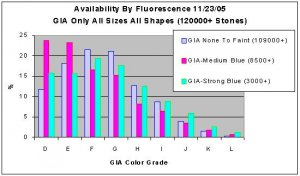Hi, I am considering a couple different diamonds from an on line site. One that I like has Strong Blue Flourescence. I see the topic covered in another section, but here is my exact question:
I don''t care how it looks under a black light, but I don''t want it to look weird in regular light or office light. What is your experience with this - can you tell that a stone is blue looking or something funny in normal light?
I had this stone viewed by someone on the other side of the internet sales site and they said it had, "faint to no effect". I don''t know - Do they actually look different than any other diamond in *regular* light. Any opinions?
The stone is F color 2.12 ct. Any help I really would appreciate - it is drivng me nuts - I cannot make the purchase decision!!!
I don''t care how it looks under a black light, but I don''t want it to look weird in regular light or office light. What is your experience with this - can you tell that a stone is blue looking or something funny in normal light?
I had this stone viewed by someone on the other side of the internet sales site and they said it had, "faint to no effect". I don''t know - Do they actually look different than any other diamond in *regular* light. Any opinions?
The stone is F color 2.12 ct. Any help I really would appreciate - it is drivng me nuts - I cannot make the purchase decision!!!








300x240.png)